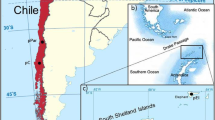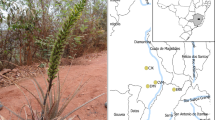Abstract
The genetic variability and population genetic structure of six populations of Praecereus euchlorus and Pilosocereus machrisii were investigated. The genetic variability in single populations of Pilosocereus vilaboensis, Pilosocereus aureispinus, and Facheiroa squamosa was also examined. All of these cacti species have a patchy geographic distribution in which they are restricted to small areas of xeric habitats in eastern Brazil. An analysis of genetic structure was used to gain insights into the historical mechanisms responsible for the patchy distribution of P. euchlorus and P. machrisii. High genetic variability was found at the populational level in all species (P=58.9–92.8%, Ap=2.34–3.33, He=0.266–0.401), and did not support our expectations of low variability based on the small population size. Substantial inbreeding was detected within populations (FIS=0.370–0.623). In agreement with their insular distribution patterns, P. euchlorus and P. machrisii had a high genetic differentiation (FST=0.484 and FST=0.281, respectively), with no evidence of isolation by distance. Accordingly, estimates of gene flow (Nm) calculated from FST and private alleles were below the level of Nm=1 in P. machrisii and P. euchlorus. These results favored historical fragmentation as the mechanism responsible for the patchy distribution of these two species. The genetic distance between P. machrisii and P. vilaboensis was not compatible with their taxonomic distinction, indicating a possible local speciation event in this genus, or the occurrence of introgression events.
Similar content being viewed by others
References
J.J. Bigarella D. Andrade-Lima (1982) Paleoenvironmental changes in Brazil C.T. Prance (Eds) in Biological Diversifications in the Tropics Columbia University Press New York 27–40
E.L. Borba J.M. Felix V.N. Solferini J. Semir (2001) ArticleTitleFly-pollinated Pleurothallis (Orchidaceae) species have high genetic variability: evidence from isozyme markers Am. J. Bot. 88
T.H. Boyle (1997) ArticleTitleThe genetics of self-incompatibility in the genus Schlumbergera (Cactaceae) J. Hered. 88 209–214
W.A. Calder (1990) ArticleTitleTerritorial hummingbirds Nat. Geog. Res. 7 56–69
C.M. Clapperton (1993) ArticleTitleNature of environmental changes in South America at the Last Glacial Maximum Palaeo 101 189–208
R. Clark-Tapia F. Molina-Freaner (2003) ArticleTitleThe genetic structure of a columnar cactus with a disjunct distribution: Stenocereus gummosus in the Sonoran desert Heredity 90 443–450 Occurrence Handle10.1038/sj.hdy.6800252 Occurrence Handle12764419
R. Clark-Tapia C. Alfonso-Corrado L.E. Eguiarte F. Molina-Freaner (2005) ArticleTitleClonal diversity and distribution in Estenocereus erucas (Cactaceae), a narrow endemic cactus of the Sonoran Desert Am. J. Bot. 92 272–278
J.F. Crow K. Aoki (1984) ArticleTitleGroup selection for a polygenic behavioral trait: estimating the degree of population subdivision. Proc. Natl. Acad. Sci USA 81 6073–6077
K. Faegri L. Pijl ParticleVan Der (1979) The Principles of Pollination Ecology Pergamon Press London
T.H. Fleming J.N. Holland (1998) ArticleTitleThe evolution of obligate mutualism: the senita and senita moth Oecologia 114 368–378 Occurrence Handle10.1007/s004420050459
A.H. Gentry (1995) Diversity and floristic composition of neotropical dry forests S.H. Bullock H.A. E. Mooney Medina (Eds) in Seasonally Dry Tropical Forests Cambridge University Press Cambridge 146–194
J.P. Gibbs (2001) ArticleTitleDemography versus habitat fragmentation as determinants of genetic variation in wild populations Biol. Conserv. 100 15–20 Occurrence Handle10.1016/S0006-3207(00)00203-2
A.M. Giulietti J.R. Pirani (1988) Patterns of geographic distribution of some plant species from the Espinhaço Range, Minas Gerais and Bahia, Brazil W.R. P.E. Heyer Vanzolini (Eds) in Proceedings of a Workshop on Neotropical Distribution Patterns Academia Brasileira de Ciências Rio de Janeiro 39–69
J. Goudet (2001) ArticleTitleFSTAT, a program to estimate and test gene diversities and fixation indices (version 2.9.3). Available from http://www.unil.ch/izea/softwares/fstat.html. Updated from J. Goudet, 1995 FSTAT (Version 1.2) a computer program to calculate F-statistics J. Hered. 86 485–486
J.L. Hamrick M.J.W. Godt (1989) Allozyme diversity in plant species A.H.D. Brown M.T. Clegg A.L. Kahler B.S. Weir (Eds) in Plant Population Genetics, Breeding and Genetic Resources Sinauer Sunderland 43–63
J.L. Hamrick M.J.W. Godt S.L. Siierman-Broyles (1992) ArticleTitleFactors influencing levels of genetic diversity in woody plant species New Forests 6 95–124 Occurrence Handle10.1007/BF00120641
J.L. Hamrick J.D. Nason T.H. Fleming J.M. Nassar (2002) Genetic diversity in columnar cacti T.H. Fleming A. Valient-Banuet (Eds) in Evolution, Ecology and Conservation of Columnar Cacti and their Mutualists University of Arizona Press Tucson 43–63
S. Holm (1979) ArticleTitleA simple sequentially rejective multiple test procedure Scand. J. Stat. 6 65–70
F.F. Jesus V.N. Solferini J. Semir P.I. Prado (2001) ArticleTitleLocal genetic differentiation in Proteopsis argentea (Asteraceae), a perennial herb endemic in Brazil Plant. Syst. Evol. 226 59–68 Occurrence Handle10.1007/s006060170073
D.A. Levin (1993) ArticleTitleLocal speciation in plants: the rule not the exception Syst. Bot. 18 197–208
E. Locatelli I.C. Machado P. Medeiros (1997) ArticleTitleFloral biology and bat pollination in Pilosocereus catingicola (Cactaceae) in northeastern Brazil Bradleya 15 28–34
M.D. Lovelles J.L. Hamrick (1984) ArticleTitleEcological determinants of genetic structure in plant populations Ann. Rev. Ecol. Syst. 15 65–95 Occurrence Handle10.1146/annurev.es.15.110184.000433
M.R. Macnair (1989) ArticleTitleThe potential for rapid speciation in plants Genome 31 203–210
A. Martínez-Palacios L.E. Eguiarte A.G.R. Furnier (1999) ArticleTitleGenetic diversity of the endangered endemic Agave victoriae-reginae (Agavaceae) in the Chihuahuan Desert Am. J.␣Bot. 86 1093–1098 Occurrence Handle10449387
Miller, M.P., 1997. Tools for population genetic analysis (TFPGA) 1.3: A windows program for the analysis of allozyme and molecular population genetic data. http://www.bioweb.usu.edu/mpmbio/
J.M. Nassar N. Ramirez O. Linares (1997) ArticleTitleComparative pollination biology of Venezuelan columnar cacti and the role of nectar-feeding bats in their sexual reproduction Am. J. Bot. 84 918–927
J.M. Nassar J.L. Hamrick T.H. Fleming (2001) ArticleTitleGenetic variability and population structure of the mixed-mating cactus, Melocactus curvispinus (Cactaceae) Heredity 87 69–79 Occurrence Handle10.1046/j.1365-2540.2001.00910.x Occurrence Handle11678989
J.M. Nassar J.L. Hamrick T.H. Fleming (2002) ArticleTitleAllozyme diversity and genetic structure of leafy cactus (Pereskia guamamcho, Cactaceae) J. Hered. 93 193–200 Occurrence Handle10.1093/jhered/93.3.193 Occurrence Handle12195035
J.M. Nassar J.L. Hamrick T.H. Fleming (2003) ArticleTitlePopulation genetic structure of Venezuelan chiropterophilous columnar cacti (Cactaceae) Am. J. Bot. 90 1628–1637
J.D. Nason J.L. Hamrick T.H. Fleming (2002) ArticleTitleHistorical vicariance and postglacial colonization effects on the evolution of genetic structure in Lophocereus, a Sonoran desert columnar cactus Evolution 56 2214–2226 Occurrence Handle12487352
M. Nei (1978) ArticleTitleEstimation of average heterozygosity and genetic distance from a small number of individuals Genetics 89 583–590
M. Nei (1987) in Molecular Evolutionary Genetics Columbia University Press New York
R.T. Pennington D.E. Prado C.A. Pendry (2000) ArticleTitleNeotropical seasonally dry forests and Quaternary vegetation changes J. Biogeogr. 27 261–273 Occurrence Handle10.1046/j.1365-2699.2000.00397.x
D.E. Prado P.E. Gibbs (1993) ArticleTitlePatterns of species distributions in the dry seasonal forests of South America Ann. Missouri Bot. Gard. 80 902–927
G.T. Prance (1982) ArticleTitleA review of the phytogeographic evidence for Pleistocene climatic changes in the neotropics Ann. Missouri Bot. Gard. 69 594–624
J. Reynolds B.S. Weir C.C. Cockerham (1983) ArticleTitleEstimation of the coancestry coefficient: basis for a short-term genetic distance Genetics 105 767–779
F. Ronquist (1997) ArticleTitleDispersal-vicariance analysis: a new approach to the quantification of historical biogeography Syst. Biol. 46 195–203
M. Slatkin (1985) ArticleTitleRare alleles as indicators of gene flow Evolution 39 53–65
M. Slatkin (1994) Gene flow and population structure L. Real (Eds) in Ecological Genetics Princeton University Press New Jersey 417
M. Sun F.R. Garders (1990) ArticleTitleOutcrossing rates and allozyme variation in rayed and rayless morphs of Bidens pilosa Heredity 64 139–143
N.P. Taylor ( 2000) Taxonomy and Phytogeography of the Cactaceae of Eastern Brazil. PhD Thesis The Open University England
B.S. Weir C.C. Cockerham (1984) ArticleTitleEstimating F-statistics for the analysis of population structure Evolution 38 1358–1370
S. Wright (1978) Evolution and the Genetics of Populations, Vol. 4. Variability within and among Natural Populations University of Chicago Press Chicago
A. Young T. Boyle T. Brown (1996) ArticleTitleThe population genetic consequences of habitat fragmentation for plants Trends Ecol. Evol. 11 413–418 Occurrence Handle10.1016/0169-5347(96)10045-8
Zappi, D.Z., 1994. Pilosocereus (Cactaceae), in The genus in Brazil, edited by D. Hunt and N. Taylor. Royal Botanic Gardens, Kew
Author information
Authors and Affiliations
Corresponding author
Rights and permissions
About this article
Cite this article
Moraes, E.M., Abreu, A.G., Andrade, S.C. et al. Population Genetic Structure of Two Columnar Cacti with a Patchy Distribution in Eastern Brazil. Genetica 125, 311–323 (2005). https://doi.org/10.1007/s10709-005-0716-0
Received:
Accepted:
Issue Date:
DOI: https://doi.org/10.1007/s10709-005-0716-0




